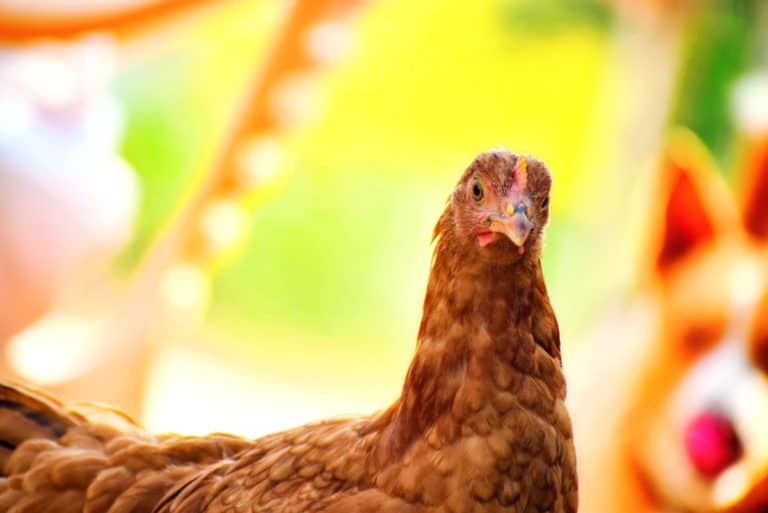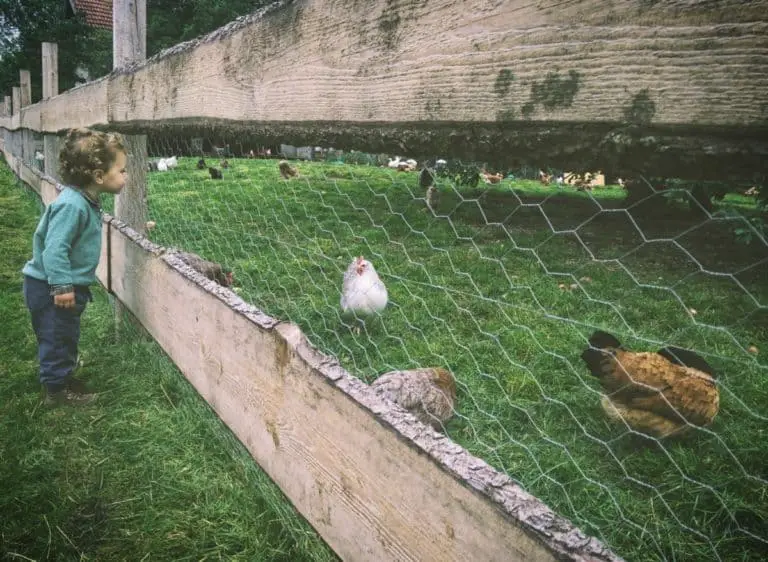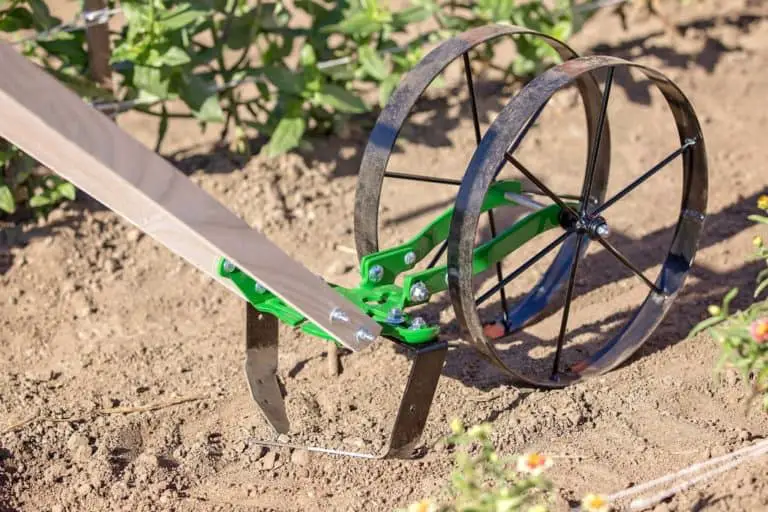
Owning a flock of chickens comes with the additional responsibility of keeping them safe. But determining what threatens them may be challenging. Let’s look at the various chicken predators, their habits, and determine a strategy to keep your chickens safe.
Just about every carnivore and omnivore in the woods that surround your home is a potential predator to your chickens. Several canine and feline species, as well as raccoons, skunks, opossums, and different varieties of the weasel family, all pose serious problems to your feathered friends. But they can be thwarted in their efforts.

Nighttime Predators
Nighttime predators can include dogs, cats, skunks, opossums, raccoons, weasels or minks, owls, foxes, coyotes, wolves, snakes, and others. Many areas don’t have a bear problem, so I didn’t list them. But they would kill chickens for certain if allowed into the pen at night.
But, some of the easiest predators to stop are nighttime predators. The chickens are all snuggled up on their roost and they are all in one place. That makes predator prevention a lot easier, but only if you have made the right precautions.
Having the chickens (the prey) in one place means that you only have to prevent entry to that one place. This can be accomplished by several methods, and some of these methods can be implemented in daytime protection too.
First, there is the coop. How secure is it? Are there holes in the wire surround? Are there gaps in the fencing or structure? A critical inspection needs to be done before you add chickens, or for sure at the first sign of predation on your property.
Look for the smallest area of entry. I had an opossum gain entry from a gap that was less than a couple of inches wide. He did a lot of damage in just a few days, killing 13 chickens before I saw the small opening. So be very critical when looking for an access point. Think like a small animal, and inspect closely. A coyote might not be able to get into a small opening, but a mink surely could.
I’ve found that nighttime predators can be quickly stopped by an electric fence. In fact, I don’t even lock my chickens up at night anymore. Their door is always wide open.
I place the hot wire just above the ground around the perimeter of the chicken house. It’s on a timer and is set to come on after they have gone to bed. The actual set time will vary depending on the length of days (season) and the bi-yearly changes in daylight savings time.

I’ve never lost a chicken to a ground predator since I installed my “perimeter electric fence”. It just works that well. It’s not because I don’t have any predators either. I know for sure I have raccoons, skunks, foxes, opossums… all the small predators on or near my property.
Since the electric wire is close to the ground, all the small predators would touch the wire as they try to gain access. A good fence charger that produces a hard jolt of electricity will probably mean that they won’t come back, at least not for a long time.
It has to be a GOOD Electric Fence. One that just gives them a little tingle will not deter them from dinner. Here’s one at Amazon (my affiliate link) that I found to be very effective in delivering the jolt they need. Look for one that is at least 1-Joule and preferably 2-Joules or above. “Joules” is the measure of “shock value” that the charger produces. Higher Joules is better. There are many that are very good, and Patriot is my brand of choice (my affiliate link).
Just to clarify, I’ve never had one from Tractor Supply, etc. that was powerful enough to stop a determined animal.
I have several videos on my YouTube Channel showing my chicken house electric fence setup, and many have implemented it on their property.
Nighttime predators also include owls. An owl is nocturnal and will choose the cover of darkness to come for your chickens. Obviously, a hot wire near the bottom of your coop won’t be a deterrent to an owl, so you’ll have to make sure your pen is buttoned-up as discussed above. No gaps.
Snakes can be a problem because they will eat your eggs. But they also can kill small chickens a month old or less. Snakes can get into just about any hole and are very hard to keep out.
My next-door neighbor has an electrified fence (or hot wire) around his chicken pen at my advice. He told me that a fox had a litter of babies just a few yards from his coop, under some metal scrap. But he’s never lost a chicken to a fox since he installed the hot wire. It works that well.

Even for midsized and large predators, an electric fence is, in my opinion, the best deterrent. I don’t have a bear population, but a good electric fence will absolutely deter a bear. They are used all over Alaska, and other areas where bears are prevalent.
For larger predators, the hot wire would obviously have to be placed higher than the other wire, and since you would be walking in and out the door, there would have to be a latch you could use to let yourself in and out. That’s not a problem since there are many different kinds of “latches” for hot wires.
My “coop” is inside a large “chicken run”. I don’t have an electric fence around the “run’ but I do have it around the coop. If there was ever a breach of the “run” by a larger animal, I would have to install one around the perimeter of the run too, and probably a higher wire around the coop, but so far, I haven’t had to.
So, that takes care of nighttime predators. Just a “critter-tight” coop and a strategically placed hot wire low to the ground. So far so good and that will prevent most of the predation on chickens. Most kills are at night. But not all.
Daytime Predators
The daytime predators will include many of the above. There are threats from canines (dog, coyote, foxes, etc.) as well as others from the feline family (bobcats, cougars, etc.) and even others that will attack from the air. Let’s look at the daytime ground predators first.
For ground predation, the best defense is a very good fence. A fence that will not allow these animals on your property. Chain-link fence, woven fence, electric fencing are all good ways to keep predators out.
Earlier I mentioned dogs. For many, if not most of those that raise chickens, the neighborhood stray dog will be your worse predator problem. Especially if you are in an urban environment. Many are keeping chickens in the city now, and it’s becoming very popular to have backyard poultry.
If you don’t have a fenced-in yard, you are opening yourself up to predation (daytime and nighttime) from domesticated animals. Most of the problems will come from dogs (perhaps even your own), but cats will kill chickens too. I don’t think cats are as bad of a threat, but it certainly is possible.
If your chickens are in a coop and run, or a “chicken tractor” during the day, you shouldn’t have to worry about that, but if they “free-range” on your acreage, or even in your backyard, you’ll have to take precautions to prevent predation from the neighborhood prowlers.
If you choose to “free-range” you’ll want to read this article about the benefits and pitfalls of implementing a Free-Range system.
Many choose a Livestock Guard Dog (LGD) to stay outside on their property with the animals. Their only job in life is to guard whatever livestock you put them in charge of. A good LGD is relentless in their protection and will give their life for the “family” they protect.
The Great Pyrenees is one of the favorite choices for those that use LGDs.
A popular method of protection has become the Electrified Netting. This moveable netting can be placed as a perimeter fence with your chickens inside it. It works to keep the chickens inside, but the electrified netting’s main job is to keep the predators out.
As I said, it’s moveable. The posts are placed in the ground by just stepping on them and pushing them into the ground. Having a “moveable” fence means that whenever the chickens have finished with an area, they can move to another area with very little effort on your part. Here is a nice electro-netting setup at Amazon (my affiliate link) for you to consider.
Aerial Predators
But, during the daytime hours, and whether you are in the country or a city getting, an assault from the air is very possible. Hawks and eagles can snatch a chicken up before they ever knew they left the ground.

A lot of hawks aren’t large enough to fly off with a full-grown chicken, so many times they will pounce on the chicken, kill and eat it (partially) it on the ground. An eagle is typically large enough to fly off with a chicken, and you won’t find any evidence of what happened. Maybe a few feathers, but not much.
For an aerial assault, the only thing that is for sure is bird netting. It has to be placed in service strategically, with no gaps for the aerial predators to find their way in.
If your chickens are “free-range” it will be very difficult to cover the entire area they roam with bird netting. So, you may want to try one of these less effective approaches.
Streamers, fake snakes, fake owls are just a few things that are used to try to thwart an air attack from a hawk or eagle. They are moderately successful but certainly worth a try.
I’m told that a Livestock Guard Dog is very effective against aerial attacks. They will sense or see the danger and chase the predator bird off.
Also, try to give your chickens cover to run to when they sense danger. Many times, my chickens will hear a hawk and will run inside their coop. Sometimes I will make a whistling sound that mimics a hawk’s cry and my chicken’s heads go up, looking for danger… and cover.
So, having a safe place for them to run can be very beneficial, and might just save the life of your dearest feathered friends.
I hope this helps you in your efforts to make your chickens’ lives as safe as possible.
I have an entire Playlist on My YouTube Channel dealing with predators on the Homestead, and how to keep them away.
I also have around 800 other videos dealing with Raising Livestock, Gardening, Farming, and Emergency Preparedness on My Channel. You can find it HERE
I know your time is valuable. Thanks for spending some of it here.







